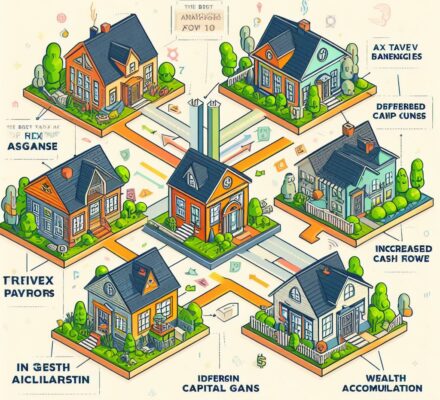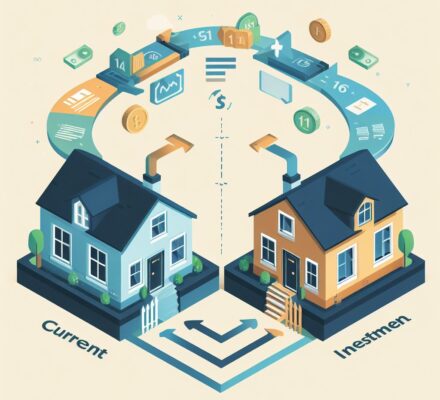Looking to maximize your long-term tax advantages? Dive into the world of 1031 exchanges.
This guide will walk you through the ins and outs of this powerful tax strategy. From understanding eligibility and qualifying properties to navigating the step-by-step process, we’ll cover it all.
Discover the potential tax benefits and learn how to avoid common pitfalls.
Get ready to take control of your tax situation and make the most of your investments with a 1031 exchange.
Key Takeaways
- A 1031 exchange allows you to defer capital gains taxes on the sale of an investment property.
- The properties involved in a 1031 exchange must be of like-kind, meaning they are similar in nature and use.
- Eligible properties for a 1031 exchange include residential rental properties, commercial properties, vacant land, and rental vacation homes.
- By continuously deferring taxes through multiple 1031 exchanges, you can potentially accumulate significant wealth over time.
Understanding the 1031 Exchange
To fully grasp the benefits of a 1031 exchange, you’ll need to understand how this tax-deferment strategy works. A 1031 exchange, also known as a like-kind exchange, allows you to defer capital gains taxes on the sale of an investment property by reinvesting the proceeds into another similar property. This strategy is based on the principle that if you exchange one investment property for another of equal or greater value, you shouldn’t have to recognize any gains for tax purposes.
The key requirement of a 1031 exchange is that the properties involved must be of like-kind. This means that the properties must be similar in nature and use. For example, you can exchange a residential rental property for another residential rental property, or a commercial property for another commercial property.
Additionally, there are strict time restrictions for completing a 1031 exchange. Once you sell your original property, you have 45 days to identify potential replacement properties. You must then close on the purchase of one or more of these identified properties within 180 days from the sale of your original property.
Eligibility and Qualifying Properties
To be eligible for a 1031 exchange, you must meet certain requirements and have qualifying properties. The Internal Revenue Service (IRS) has established guidelines to ensure that the exchange is conducted in a manner that promotes legitimate investment activity. One of the key requirements is that both the relinquished property (the property you give up) and the replacement property (the property you acquire) must be held for investment or used in a trade or business.
Qualifying properties for a 1031 exchange can include various types of real estate, such as residential rental properties, commercial properties, vacant land, and even vacation homes that are used for rental purposes. However, personal residences and inventory properties, such as properties held primarily for sale, do not qualify for a 1031 exchange.
Here is a table summarizing the eligibility and qualifying properties for a 1031 exchange:
| Eligibility Requirements | Qualifying Properties |
|---|---|
| Held for investment or used in trade or business | Residential rental properties, commercial properties, vacant land, rental vacation homes |
| Not personal residences or inventory properties | Not personal residences or properties held primarily for sale |
Understanding the eligibility requirements and qualifying properties is essential before proceeding with a 1031 exchange. Now, let’s move on to the step-by-step process for a 1031 exchange.
(Note: Transition sentence to be added in the next section)
Step-by-Step Process for a 1031 Exchange
Now, let’s dive into the step-by-step process for completing a 1031 exchange, guiding you through each crucial stage.
The first step is to identify the replacement property within 45 days of selling your current property. This identification must be done in writing and submitted to a qualified intermediary (QI) who’ll hold the funds from the sale of your property. You can identify up to three potential replacement properties or any number of properties as long as they meet certain valuation requirements.
Next, you need to enter into a purchase agreement for the replacement property. It’s essential to include specific language in the agreement stating that the transaction is part of a 1031 exchange. This ensures that the proceeds from the sale of your current property are transferred to the QI and not directly to you, preserving the tax-deferred status of the exchange.
After entering into the purchase agreement, you have 180 days from the sale of your current property to close on the replacement property. During this time, the QI will hold the funds and facilitate the exchange. It’s crucial to adhere to all deadlines and requirements to maintain the tax benefits of the exchange.
Once the replacement property is acquired, the 1031 exchange process is complete. It’s important to consult with a tax professional to ensure compliance with all IRS rules and regulations to maximize the tax advantages of the exchange.
Potential Tax Benefits of a 1031 Exchange
One potential tax benefit of a 1031 exchange is that it allows you to defer capital gains taxes on the sale of your property. When you sell a property that has appreciated in value, you’d typically be subject to paying capital gains taxes on the profit. However, with a 1031 exchange, you can reinvest the proceeds from the sale into a like-kind property and defer the payment of those taxes.
By deferring capital gains taxes, you can keep more money working for you in your investments. This allows you to leverage the full value of your property without having to pay an immediate tax burden. The ability to defer taxes provides you with increased liquidity and flexibility, enabling you to reinvest the full amount of your proceeds into a new property.
Furthermore, by continuously deferring capital gains taxes through multiple 1031 exchanges, you can potentially accumulate significant wealth over time. The compounding effect of deferring taxes allows you to reinvest and grow your investments without the burden of immediate tax payments.
It is important to note that while a 1031 exchange allows you to defer capital gains taxes, it isn’t a tax-free transaction. Eventually, when you sell the final property without engaging in another 1031 exchange, you’ll be required to pay the accumulated taxes. However, until that time comes, you can enjoy the benefits of deferral and maximize your long-term investment potential.
Now that you understand the potential tax benefits of a 1031 exchange, it’s important to be aware of some common pitfalls to avoid in order to ensure a successful and compliant exchange process.
Common Pitfalls to Avoid in a 1031 Exchange
Be cautious of certain pitfalls to avoid in a 1031 exchange to ensure a successful and compliant process. A 1031 exchange can be a complex transaction with several potential pitfalls that could jeopardize its tax-deferred status. To help you navigate this process smoothly, here are some common pitfalls to be aware of:
- Strict timeline: The IRS imposes strict deadlines for identifying and acquiring replacement properties. Failure to meet these deadlines can result in disqualification of the exchange.
- Improper identification: It’s crucial to accurately identify potential replacement properties within the specified timeframe. Failing to identify properties in the correct manner can lead to invalidation of the exchange.
- Ineligible properties: Ensure that the replacement property meets the criteria set by the IRS. Certain types of property, such as personal residences or inventory, aren’t eligible for a 1031 exchange.
- Mismatched values: The value of the replacement property must be equal to or greater than the relinquished property. Any leftover cash or reduction in mortgage debt may be subject to capital gains tax.
- Inadequate record-keeping: Maintain detailed and accurate records throughout the exchange process. This will help substantiate your claim if the IRS were to audit your exchange.
Frequently Asked Questions
Are There Any Time Limits or Deadlines for Completing a 1031 Exchange?
Yes, there are time limits and deadlines for completing a 1031 exchange. It is important to be aware of these deadlines to ensure the successful completion of your exchange and the associated tax advantages.
Can a 1031 Exchange Be Used for Personal Properties, Such as a Primary Residence or Vacation Home?
Yes, a 1031 exchange can be used for personal properties like your primary residence or vacation home. However, there are certain criteria that must be met to qualify for the tax advantages.
What Happens if the Replacement Property Identified in a 1031 Exchange Is Not Available or Falls Through?
If the replacement property identified in a 1031 exchange is not available or falls through, you may lose the tax advantages and be responsible for paying capital gains taxes on the sale of the original property.
Are There Any Restrictions on the Location of the Replacement Property in a 1031 Exchange?
When it comes to the location of the replacement property in a 1031 exchange, there are certain restrictions you need to be aware of. These restrictions dictate where you can and cannot invest your funds.
Can a 1031 Exchange Be Used to Defer Taxes on the Sale of Multiple Properties at Once?
Yes, a 1031 exchange can be used to defer taxes on the sale of multiple properties at once. It allows you to reinvest the proceeds into like-kind properties, deferring capital gains taxes.




